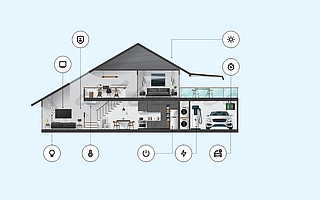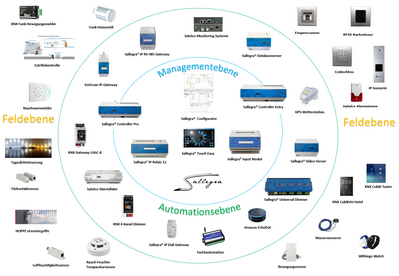Levels in building automation
Building automation is generally divided into three levels: the management, automation and field level. They require different technical equipment and perform very specific tasks within building services engineering, which are described in condensed form below. With Satelco's solutions and products, you cover all three levels, so you get a complete system for building automation from one source.
Management level
At the management level, the individual systems of a building are controlled and monitored, and their working and operating methods are optimized. In the event of faults in one or more components of the building services engineering, the management level sends a corresponding alarm.
The tasks also include the visualization of previously recorded and statistically processed data volumes. The respective data from the other levels are used to optimize the processes. Special software is used for the building management system, which has certain differences and advantages and disadvantages depending on the provider. However, there is also manufacturer-independent software with corresponding interfaces.
The management level thus has a superordinate function compared to the other two levels. A normal PC with a redundant database and back-up facilities as well as an uninterruptible power supply serves as the minimum technical equipment. Management systems can be implemented centrally or distributed with several operating units, the latter based on a client-server architecture.
Automation level
The automation level takes over the regulation and control of the technical systems with the help of the data from the field level and the specifications from the management level. Here, interoperability should be guaranteed in order to enable manufacturer-independent data exchange.
Today, all automation equipment is designed in digital technology and, in addition to control, also monitors limit values, switching states, current counter readings, etc. In the automation stations, the resulting data is processed and then forwarded to the field or management level.
Field level
On the lowest level there are sensors and actuators, the so-called field devices, with which the individual technical components of a building are operated. The sensors have the task of recording environmental information - such as movements, temperature, brightness, etc. - and to transmit this information to the actuators via a bus system. These in turn receive and interpret the data and then convert them into corresponding switching signals for heating, lighting, ventilation or air conditioning. The field level thus provides data and information for the two higher levels. Due to the rapid technical development, especially in microprocessors, the boundaries between the field and automation levels are becoming blurred.

